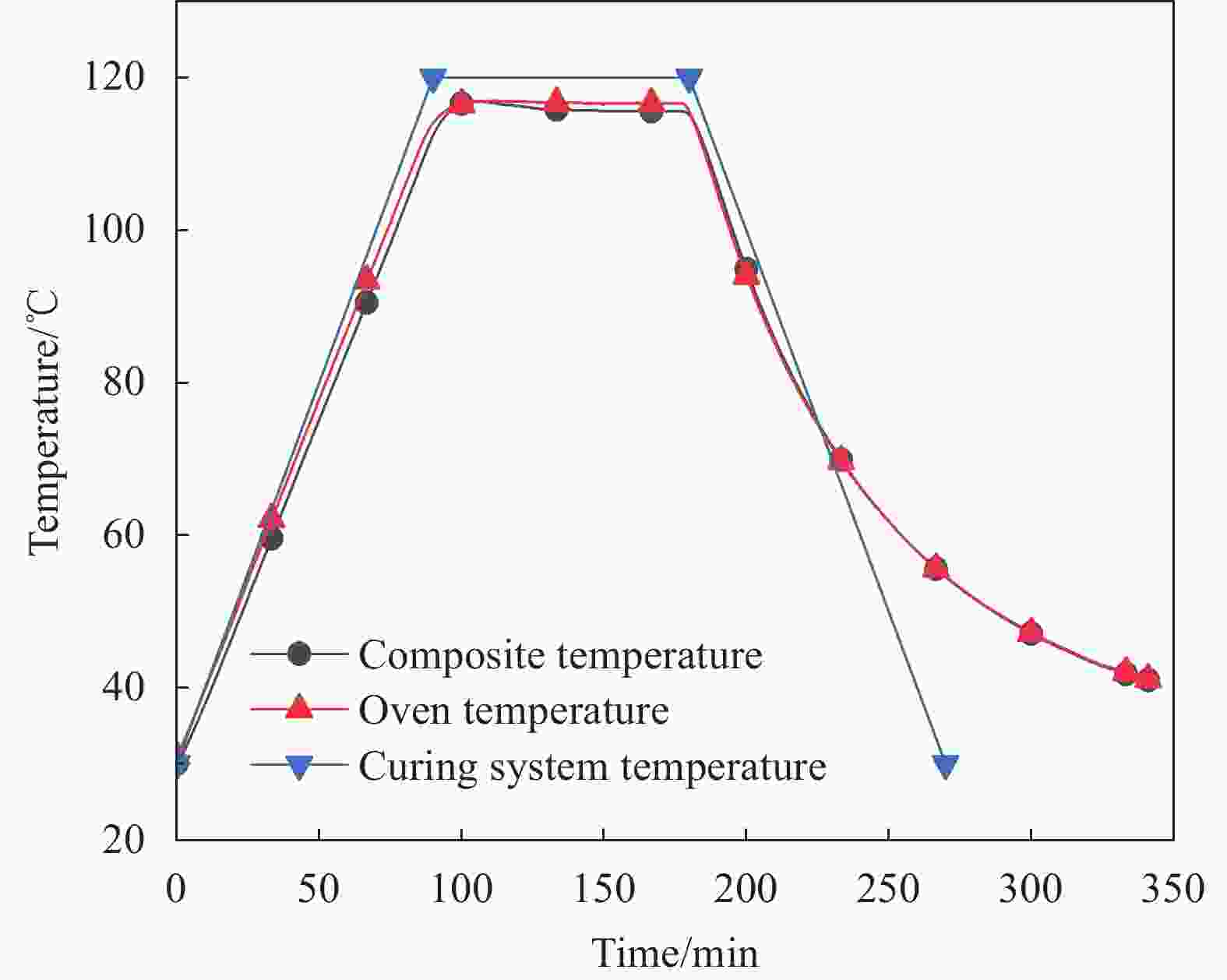In-situ testing method for residual strain of cured composite materials
-
摘要: 复合材料固化残余应变是导致复合材料固化变形的主要原因,残余应变也会导致复合材料产生裂纹、分层等缺陷,影响复合材料构件装配与构件性能,因此,复合材料固化残余应变原位检测方法研究具有重要意义。本文建立了一种复合材料固化残余应变应变片原位检测方法,根据复合材料凝胶点将复合材料固化分橡胶态和玻璃态两个阶段,针对这两个阶段分段式处理应变片原位检测复合材料固化残余应变数据,对应变片原位检测数据分别采取去除应变片热膨胀和不去除热膨胀的处理方法。基于分段式处理方法,测试了碳纤维热固性复合材料真空袋固化成型0°和90°方向上的应变变化,并与光纤光栅(FBG)原位检测结果进行对比分析,揭示了复合材料固化残余应变的形成机理。研究结果表明,应变片原位检测数据分段式处理结果与FBG结果基本吻合,可以有效分析复合材料固化过程残余应变的演化规律。Abstract: During the curing process of composites, residual strain will inevitably occur, which will change continuously with the curing of composites, and residual strain is the main reason leading to the final curing deformation of materials. The concentration of residual strain may cause cracks and lamination of composites, which will bring difficulties to the assembly of composite components and affect the performance of components. It is of great significance to study the in-situ detection method of curing residual strain of composites. In this study, a strain gauge in-situ detection method for curing residual strain of composites is established, and a piece-wise curing residual stress and strain gauge data processing method is proposed. The curing of composites is divided into two stages at the gel point of composites. For these two stages, different processing methods are adopted for in-situ strain gauge detection data. The strain changes in the direction of 0° and 90° were measured and compared with the results of fiber Bragg grating (FBG) in situ, which revealed the formation mechanism of the cured residual strain of the composite. The results show that the piece-wise processing of in-situ strain gauge data is basically consistent with the results of FBG, which can effectively analyze the evolution law of residual strain during solidification of composites.
-
表 1 应变片参数
Table 1. Resistance strain gauge parameters
Type Maximum
service
temperature/℃Strain
sensitivity coefficientGridarea/
mmRsistance/
ΩBA120-3AA 250 2.1±0.01 3×2 120 表 2 FBG传感器参数
Table 2. Parameters of FBG sensor
Parameters Values Grating length Ls 10 mm Initial Bragg grating period λB 1540 nm~1552 nm Coefficient of axial strain Sensitivity Sε 1.174 pm/με Coefficient of temperature Sensitivity ST 11.033 pm/℃ 表 3 应变片及FBG检测结果100℃~45℃降温段应变变化比较
Table 3. Comparison of strain change results measured by strain gauge and FBG in 100℃~45℃ cooling section
Checking angle FBG-Experiment-1 FBG-Experiment-2 Average Strain gage-Experiment-1 Strain gage-Experiment-2 Average 0° 32.4 33.2 32.8 36.7 37.3 37 90° −1903.1 −2030 −1966.5 −1900 −2172.2 −2036.1 -
[1] SORRENTINO L, BELINI C. Compaction influence on spring-in of thin composite parts: Experimental and numerical results[J]. Journal of Composite Materials, 2015, 49(17): 2149-2158. doi: 10.1177/0021998314542362 [2] YUAN Z Y, WANG Y J, YANG G G, et al. Evolution of curing residual stresses in composite using multi-scale method[J]. Composites Part B: Engineering, 2018, 155: 49-61. doi: 10.1016/j.compositesb.2018.08.012 [3] CHAVA, SANDEEP, SIRISH N. Continuous evolution of processing induced residual stresses in composites: An in-situ approach[J]. Composites Part A-applied Science and Manufacturing, 2021, 145: 106368. doi: 10.1016/j.compositesa.2021.106368 [4] JOHNSTON, ANDREW. An integrated model of the development of process-induced deformation in autoclave processing of composite structures [D]. The University of British Columbia 1998. [5] DING A X, LI S X, WANG J H, et al. A new path-dependent constitutive model predicting cure-induced distortions in composite structures[J]. Composites Part A: Applied Science and Manufacturing, 2017, 95: 183-196. doi: 10.1016/j.compositesa.2016.11.032 [6] SVANBERG, J. MAGNUS, JONAS H. Prediction of shape distortions Part I. FE-implementation of a path dependent constitutive model[J]. Composites Part A: Applied Science and Manufacturing, 2004, 35(6): 711-721. doi: 10.1016/j.compositesa.2004.02.005 [7] DING A X, LI S X, WANG J H, et al. A thermo-viscoelastic model of process-induced residual stresses in composite structures with considering thermal dependence[J]. Composite Structures, 2016, 136: 34-43. doi: 10.1016/j.compstruct.2015.09.014 [8] KISTER G, DOSSI E. Cure monitoring of CFRP composites by dynamic mechanical analyzer[J]. Polymer Testing, 2015, 47: 71-78. doi: 10.1016/j.polymertesting.2015.08.009 [9] HARDIS R, JESSOP J L P, PETERS F E, et al. Cure kinetics characterization and monitoring of an epoxy resin using DSC, Raman spectroscopy, and DEA[J]. Composites Part A: Applied Science and Manufacturing, 2013, 49: 100-108. doi: 10.1016/j.compositesa.2013.01.021 [10] ANTONUCCI V, GIORDANO M, CUSANO A, et al. Real time monitoring of cure and gelification of a thermoset matrix[J]. Composites Science and Technology, 2006, 66(16): 3273-3280. doi: 10.1016/j.compscitech.2005.07.009 [11] 巴德欣, 董永康. 分布式光纤传感技术及其在航空航天领域的应用展望[J]. 宇航学报, 2020, 41(6): 730-738.BA D X, DONG Y K. Distributed optical fiber sensing technology and its application prospect in aerospace field[J]. Acta Astronautica, 2020, 41(6): 730-738(in Chinese). [12] MULLE M, COLLOMBET F, OLIVIER P, et al. Assessment of cure residual strains through the thickness of carbon-epoxy laminates using FBGs, Part I: elementary specimen[J]. Composites Part A: Applied Science and Manufacturing, 2009, 40(1): 94-104. doi: 10.1016/j.compositesa.2008.10.008 [13] GUEMES J A, MENENDEZ J M. Response of Bragg grating fiber-optic sensors when embedded in composite laminates[J]. Composites Science and Technology, 2002, 62(7/8): 959-966. [14] 卢少微, 高禹, 张海军, 等. 树脂传递模塑成型的光纤光栅检测[J]. 高分子材料科学与工程, 2013, 29(1): 119-122.LU S W, GAO Y, ZHANG H J, et al. Fiber Bragg grating testing for resin transfer molding[J]. Polymer materials Science and engineering, 2013, 29(1): 119-122(in Chinese). [15] CANAL L P, BENAVENTE M, HAUSMANN M, et al. Process-induced strains in RTM processing of polyurethane/carbon composites[J]. Composites Part A: Applied Science and Manufacturing, 2015, 78(4): 264-273. [16] MICHAEL W N, JACOB W S, et al. Life cycle strain monitoring in glass fiber reinforced polymer laminates using embedded fiber Bragg grating sensors from manufacturing to failure[J]. Journal of Composite Materials, 2014, 48(3): 365-381. doi: 10.1177/0021998312472221 [17] DING A X, LI S X, WANG J H, et al. Experimental and numerical investigation of tool-part interaction on the process-induced distortions in composite structures[J]. Composite Structures, 2022, 279: 114871. doi: 10.1016/j.compstruct.2021.114871 [18] CHEN J L, WANG J H, LI X Y, et al. Monitoring of temperature and cure-induced strain gradient in laminated composite plate with FBG sensors[J]. Composite Structures, 2020, 242: 112-168. [19] WACHTARCZYK K, BENDER M, FAUSTER E, et al. Gel Point Determination in Resin Transfer Molding Process with Fiber Bragg Grating Inscribed in Side-Hole Elliptical Core Optical Fiber[J]. Materials, 2022, 15(18): 6497. doi: 10.3390/ma15186497 [20] DANIEL I M, LIBER T. Effect of laminate construction on residual stresses in graphite/polyimide composites[J]. Experimental Mechanics, 1977, 17(1): 21-25. doi: 10.1007/BF02324267 [21] CRASTO A S, KIM R Y, RUSSELL J D. In situ monitoring of residual strain development during composite cure[J]. Polymer composites, 2002, 23(3): 454-463. doi: 10.1002/pc.10447 [22] 游敏, 郑小玲, 郑勇, 等. 树脂基复合材料内应力测试与分析[J]. 复合材料学报, 2004, 21(4): 29-32.YOU M, ZHENG X L, ZHENG Y, et al. Test and analysis of internal stress of resin matrix composites[J]. Acta Materiae Compositae Sinica, 2004, 21(4): 29-32(in Chinese). [23] WISNOM M R, GIGLIOTTI M, ERSOYN, et al. Mechanisms generating residual stresses and distortion during manufacture of polymer–matrix composite structures[J]. Composites Part A: Applied Science and Manufacturing, 2006, 37(4): 522-529. doi: 10.1016/j.compositesa.2005.05.019 [24] KANERVA M, ANTUNES P, SARLIN E, et al. Direct measurement of residual strains in CFRP-tungsten hybrids using embedded strain gauges[J]. Materials & Design, 2017, 127: 352-363. [25] 张明, 安学锋, 唐邦铭等. 高性能双组份环氧树脂固化动力学研究和TTT图绘制[J]. 复合材料学报, 2006, (1): 17-25.ZHANG M, AN X F, TANG B M, et al. Study on curing kinetics and TTT diagram of high performance two-component epoxy resin[J]. Acta Materiae Compositae Sinica, 2006, (1): 17-25(in Chinese). -

 点击查看大图
点击查看大图
计量
- 文章访问数: 110
- HTML全文浏览量: 62
- 被引次数: 0





 下载:
下载:








